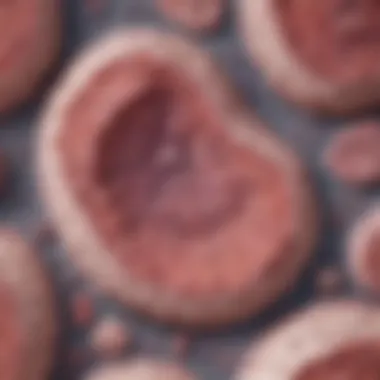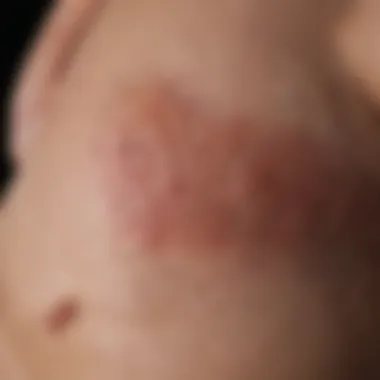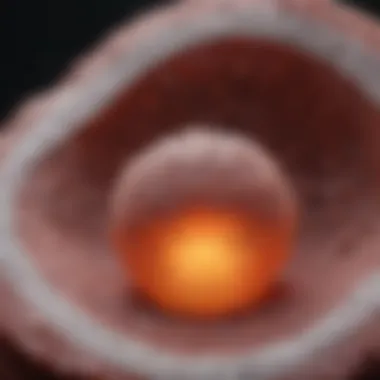Differential Diagnosis of Squamous Cell Carcinoma


Intro
Squamous cell carcinoma (SCC) is recognized as a prevalent type of skin cancer that can also arise in various epithelial tissues. Given its commonality, differentiating SCC from other entities is critical for accurate diagnosis and effective management. This section unfolds the key aspects of the differential diagnosis process, discussing the various clinical and histological features that set SCC apart from other similar conditions.
Research Highlights
Overview of Key Findings
The differential diagnosis of SCC involves careful analysis of clinical presentations and histological evidence. Key findings include:
- Distinct histological markers that characterize SCC compared to benign conditions.
- The presentation of SCC can mimic other malignancies, leading to potential misdiagnosis.
- Understanding previous research is vital in advancing diagnostic practices and improving patient outcomes.
Significance of the Research
Delving into the differential diagnosis is essential not only for SCC but also for other similar malignancies. Misdiagnosis carries implications for treatment and prognosis, making it necessary to establish clarity in distinguishing SCC from:
- Basal cell carcinoma (BCC)
- Keratoacanthoma
- Melanoma
- Other non-malignant lesions
The significance extends to developing guidelines for clinicians to enhance accuracy in diagnosis and avoid unnecessary treatments.
Diagnostic Approaches
Clinical Manifestations
SCC typically presents itself on sun-exposed areas, and common symptoms include:
- A growing, rough, crusty lesion
- Open sore that does not heal
- Changes in existing skin growths
These manifestations, while common, can also occur in other skin conditions. Therefore, in-depth examination and patient history are crucial.
Histological Features
Histologically, SCC is characterized by:
- Keratinization and atypical keratinocytes
- Invasion into the dermis
- Presence of a desmoplastic stroma
It is important to differentiate these features from other squamous cell lesions to avoid confusion.
Culmination
The differentiation of SCC requires a robust understanding of clinical presentations and histological characteristics. By advancing knowledge in this field, clinicians can better navigate the complexities associated with SCC and related conditions, leading to improved diagnostic accuracy. Staying updated with the latest research and diagnostic tools is essential for anyone involved in the field of dermatology and oncology.
Understanding Squamous Cell Carcinoma
Understanding squamous cell carcinoma (SCC) is crucial for accurate diagnosis, effective treatment, and overall patient outcomes. As a prevalent type of skin cancer, it is important to grasp its nature, pathogenesis, and significance within the broader spectrum of malignancies involving epithelial tissues. This section lays the foundation for a clearer interpretation of SCC, enabling professionals to engage critically with the subsequent detailed explorations of differential diagnosis.
When classifying SCC, several aspects require consideration. The subtype of SCC, whether it arises from keratinizing or non-keratinizing cells, impacts its typical behaviour, treatment strategies, and prognosis. Knowing these distinctions allows healthcare providers to tailor interventions and monitor disease progression appropriately.
Additionally, understanding the epidemiological context helps identify at-risk populations. Factors like UV radiation exposure, previous skin lesions, and immunosuppressive conditions contribute to SCC's incidence. The information aids in preventive measures and targeted screening protocols which form an essential part of healthcare practice.
Moreover, elucidating the pathophysiology of SCC enhances the capability to distinguish it from other cutaneous neoplasms. This knowledge supports clinicians in their diagnostic processes, ensuring that critical conditions are not overlooked.
By deeply exploring the particularities of SCC, we position ourselves to gain insights into its clinical presentation, potential misdiagnoses, and necessary interventions.
Definition and Classification
SCC is defined as a malignant tumor originating from squamous cells, found in various tissues such as skin, lungs, and the esophagus. This malignancy can be broadly classified into two main types: keratinizing and non-keratinizing. Keratinizing SCC is more common in the skin and is associated with a higher risk of local invasion, while non-keratinizing SCC, notably found in mucosal regions, tends to have different treatment challenges and prognostic implications. The classification also extends to grade, which reflects the degree of cellular differentiation and can influence management strategies.
Epidemiology and Risk Factors
SCC is known to be one of the most common types of skin cancer, with a higher prevalence in fair-skinned individuals due to lower melanin levels which provide less protection against UV radiation. Major risk factors include:


- Environmental factors - Excessive sun exposure is the leading contributor.
- Genetic predisposition - Conditions like xeroderma pigmentosum increase susceptibility.
- Immunosuppression - Individuals with weakened immune systems, such as organ transplant recipients, are at a higher risk.
Understanding these factors informs both clinical vigilance and patient education on skin protection measures.
Pathophysiology
The pathophysiology of SCC involves a multistep process of carcinogenesis, primarily prompted by DNA damage typically due to UV exposure. Genetic alterations in key genes like TP53 are frequently observed. This leads to uncontrolled cellular proliferation and, eventually, the formation of tumors. The interaction between environmental insults and genetic susceptibility shapes the individual risk and behavior of SCC. Cell signalling pathways and inflammatory responses also play roles in tumor development, progression, and metastatic potential.
Clinical Presentation of SCC
The clinical presentation of squamous cell carcinoma (SCC) serves as a critical first step in the diagnostic pathway. Recognizing the symptoms and manifestations unique to SCC allows for timely and accurate diagnosis, which is essential for effective treatment. This section will elaborate on the common symptoms associated with SCC, explore how its location affects its presentation, and discuss methods for differentiating SCC from other skin lesions.
Common Symptoms
SCC can present with a variety of symptoms that may vary in intensity and form. Common symptoms include:
- A firm, red nodule
- A rough, scaly patch that may bleed
- A sore that doesn’t heal or heals and then recurs
- Flat lesions with a scaly surface
Early detection hinges on recognizing these symptoms. However, they are not exclusive to SCC, which makes distinguishing it from other skin conditions essential. Education around these presentations is crucial for healthcare professionals and patients alike.
Location-Specific Manifestations
The location of SCC plays a significant role in its clinical manifestation. SCC commonly arises in areas of the body that are frequently exposed to sunlight, such as:
- The face
- Ears
- Neck
- Scalp
In these areas, the lesions may appear more aggressive and have a higher tendency to metastasize. Conversely, SCC may also occur in mucosal surfaces, such as the mouth and genital areas, where its appearance may differ. These nuances in presentation highlight the importance of considering anatomical location during the diagnostic assessment of SCC.
Differentiating from Other Skin Lesions
Differentiation of SCC from other skin lesions necessitates a keen clinical eye. Conditions that may mimic SCC include:
- Basal cell carcinoma
- Melanoma
- Keratoacanthoma
- Chronic non-healing ulcers or dermatitides
Criteria for differentiation can include evaluating the lesion's depth, edge characteristics, and accompanying symptoms such as itchiness or discomfort. Furthermore, a thorough patient history can provide essential clues.
"The clinical features of SCC may overlap with those of other lesions, making careful observation and clinical judgment indispensable in diagnosis."
Key Diagnostic Tools
Histopathology
Histopathology is often considered the gold standard in the diagnosis of SCC. This method involves examining tissue samples under a microscope to identify characteristic cellular features. In SCC, pathologists typically look for atypical keratinocytes, which may display irregular nuclei and abnormal keratinization. The presence of invasive characteristics, like perineural invasion or invasion into the dermis, helps further confirm the diagnosis.
Histopathological evaluation provides not just a definitive diagnosis, but also offers prognostic information. The grade of differentiation observed in SCC, whether well-differentiated, moderately differentiated, or poorly differentiated, can influence treatment decisions. This underlines the necessity of histopathology in the differential diagnostic process of SCC.
Imaging Techniques
Imaging techniques play a crucial role in assessing the extent of SCC and its possible metastasis. Non-invasive methods such as ultrasound and MRI can help visualize the depth of invasion and the involvement of surrounding structures. For example, an MRI can reveal whether the cancer has breached the subcutaneous tissue or invaded deeper structures such as muscle or bone.
CT scans are particularly useful for assessing lymph node involvement as well as distant metastasis, especially in regions like the chest or abdomen. It is important to choose the right imaging modality based on the specific characteristics of the case, considering factors such as location, stage, and patient condition.
Molecular Diagnostics
Molecular diagnostics is an emerging field that utilizes genetic testing to aid in the diagnosis and management of SCC. Techniques such as next-generation sequencing can identify mutations associated with SCC, which may impact treatment choices. For instance, the presence of specific mutations might activate targeted therapies.
Biomarkers, such as PD-L1 expression, have also garnered attention for their role in prognosis and treatment resistance. These molecular insights not only enhance the diagnostic accuracy but also tailor the therapeutic approach to individual patient needs. The relevance of molecular diagnostics continues to grow, reflecting the trend towards personalized medicine in oncology.
The combination of histopathological analysis, advanced imaging, and molecular diagnostics provides a comprehensive framework for distinguishing SCC from other conditions. This multidisciplinary approach ensures that patients receive both an accurate diagnosis and an appropriate treatment plan.
Differential Diagnosis Methods
Differential diagnosis is critical in the context of squamous cell carcinoma (SCC) as it aids in distinguishing SCC from other lesions that may exhibit similar clinical characteristics. An accurate diagnosis is essential for determining the appropriate treatment strategy and for preventing unnecessary interventions that could adversely affect patient outcomes. By employing a systematic approach to differential diagnosis, healthcare professionals can evaluate the variety of conditions that resemble SCC, ensuring they do not overlook important distinctions that can impact patient care. This section emphasizes the methodical approach to diagnostic assessment, outlines clinical criteria, and highlights the significant role of patient history.


Approach to Diagnostic Assessment
The approach to diagnostic assessment in SCC entails carefully evaluating clinical findings and considering histopathological evidence. An initial examination often includes a detailed physical assessment of skin lesions, usually noting size, color, texture, and symmetry. Healthcare professionals may then utilize diagnostic techniques such as dermoscopy or biopsy to obtain tissue samples. Histopathological examination is often fundamental, as it provides insights into cell morphology and differentiation, which are key for distinguishing SCC from other malignant entities.
Additionally, advancements in imaging technologies, such as ultrasound and MRI, contribute valuable information regarding the depth of invasion associated with tumors. When applying these techniques, it is also crucial to consider patient demographics and risk factors. The significance of a comprehensive assessment cannot be overstated; this ensures a precise diagnosis that guides effective treatment plans.
Clinical Criteria for Diagnosis
Clinical criteria for diagnosing SCC are multifaceted, relying on a combination of clinical presentation and histopathological data. The most recognized clinical features include:
- Appearance: SCC may present as a firm, red nodule, a rough, scaly patch, or a sore that bleeds and does not heal.
- Location: Common sites include sun-exposed areas, such as the face, ears, neck, and back of hands.
- Progression: Monitoring the lesion's growth pattern is vital; aggressive behavior, such as rapid enlargement or ulceration, can suggest malignancy.
From a histological perspective, the presence of atypical keratinocytes, keratin pearls, and invasion through the basement membrane serves as significant indicators. By using a combination of these clinical and histological criteria, healthcare providers can differentiate SCC from benign lesions and more aggressive skin cancers.
Role of Patient History
Patient history plays an integral role in the diagnosis of SCC. A comprehensive account of skin cancer history, previous sun exposure, and skin type can help elucidate the likelihood of malignancy. Important elements to consider include:
- Sun Exposure: Chronic ultraviolet exposure significantly increases the risk of SCC.
- Immunosuppression: A history of organ transplantation or conditions that weaken the immune system can propel SCC risk.
- Family History: Genetic predisposition to skin cancer can provide clues for diagnosis.
- Previous Skin Lesions: Any history of atypical moles or previous skin cancers should be noted.
Understanding these elements can guide clinical assessment and influence management decisions moving forward. The integration of patient history with clinical and pathological findings equips healthcare professionals to arrive at a more accurate diagnosis, ultimately enhancing patient care and management.
Common Conditions to Differentiate From
Differentiating squamous cell carcinoma (SCC) from other skin conditions is crucial for accurate diagnosis and appropriate management. Each of these common conditions presents with clinical features that may resemble SCC but require distinct treatment approaches. A clear understanding of these differences leads to better patient outcomes.
Basal Cell Carcinoma
Basal cell carcinoma (BCC) is the most prevalent form of skin cancer. Like SCC, it typically occurs in sun-exposed areas of the skin. Clinicians should note that BCC commonly appears as a pearly or waxy bump, often with visible blood vessels. In contrast, SCC may present as a scaly, red patch or a non-healing sore.
Treatment for BCC usually involves surgical excision, Mohs micrographic surgery, or topical therapies. Misdiagnosing BCC as SCC can lead to unnecessary treatments and anxiety for the patient.
Melanoma
Melanoma is a potentially aggressive form of skin cancer that arises from melanocytes. It often presents as a new or changing mole, with asymmetry and irregular borders. Understanding the differences is vital due to melanoma's higher risk of metastasis. While SCC can invade, melanoma poses a greater threat, thus requiring urgent intervention.
The ABCDE rule (Asymmetry, Border, Color, Diameter, Evolving) is a helpful guideline for identifying melanoma. Thorough assessment of skin lesions can prevent delays in treatment and improve prognosis.
Keratoacanthoma
Keratoacanthoma often appears as a rapidly growing skin lesion, presenting as a dome-shaped nodule with a central keratin-filled crater. It can mimic SCC, leading to confusion in diagnosis. However, keratoacanthomas often resolve spontaneously over time, whereas SCC tends to persist and may cause significant local tissue destruction. Proper identification is essential since treatment may vary, and misdiagnosis can alter patient management.
Dermatitis and Psoriasis
Dermatitis and psoriasis are inflammatory skin conditions that can resemble SCC in their symptoms. Dermatitis may present with red, itchy patches, while psoriasis is characterized by well-defined, silvery scales. Recognizing the inflammatory nature of these conditions helps differentiate them from SCC, which typically does not cause itching. Accurate diagnosis aids in selecting appropriate therapies – including topical steroids for dermatitis or systemic treatments for psoriasis – rather than surgical interventions designated for malignancies.
It is paramount for healthcare practitioners to recognize the differences between these conditions. Misdiagnosis can lead to inappropriate treatment and significant consequences for the patient's health.
Histological Features of SCC
Understanding the histological features of squamous cell carcinoma (SCC) is paramount in aiding the accurate diagnosis and subsequent treatment of this malignancy. The microscopic examination of tissue samples reveals crucial information about the nature of the tumor, its aggressiveness, and its potential to metastasize. This section focuses on specific elements that elucidate the diagnostic significance of SCC's histological characteristics.
Characteristic Cell Types
The characteristic cell types observed in squamous cell carcinoma are primarily keratinocytes. These cells are responsible for producing keratin, a key protein in the outer layer of the skin. In SCC, keratinocytes exhibit atypical features, including increased nuclear size, irregular nuclear contours, and prominent nucleoli. The degree of keratinization can vary, with some tumors showing well-differentiated keratinocytes that form keratin pearls, while others may appear less differentiated with a more aggressive phenotype.
Understanding the variations in cell types can help pathologists determine the grade of the tumor. For example, well-differentiated tumors tend to have less aggressive behavior compared to poorly differentiated ones. Furthermore, the presence of dyskeratotic cells or abnormal keratin production can further indicate the malignancy’s progression.
Growth Patterns
SCC can exhibit diverse growth patterns that are integral to its diagnosis. These patterns may advise on the tumor's behavior and likelihood of spread. Common growth patterns include infiltrative and exophytic types.
- Infiltrative growth involves tumor cells invading surrounding tissues, which poses a higher risk for metastasis. This can lead to challenges in complete surgical excision as the margins may not be clear.
- Exophytic growth, on the other hand, shows a more outward appearance, often leading to lesions that are easier to identify clinically. These tumors generally form raised lesions, which can be more amenable to biopsy and complete removal.


The growth pattern serves as a crucial marker for prognosis, influencing available treatment protocols effectively.
Invasion and Metastasis
The invasion and metastasis of SCC must be closely assessed during histological evaluation. Invasion is indicated by the depth of tumor penetration into the dermis and surrounding structures. The histopathological examination looks for evidence of tumor cells breaking through the basement membrane.
SCC has the potential for regional lymph node spread and distant metastasis, which heightens the importance of identifying invasive features. Notably, the presence of vascular invasion can signal a higher likelihood of metastasis. Early detection of these histological indicators is critical to managing the patient’s treatment plan effectively.
"The histological evaluation of SCC can reveal not only the type of cancer but also provide insights into its potential aggressiveness and outcomes, serving as a guide for treatment decisions."
Molecular Markers in SCC
Understanding the molecular markers in squamous cell carcinoma (SCC) is vital for advancing diagnosis and treatment. These markers can provide insights into the biological behavior of the tumor, its potential aggressiveness, and patient prognosis. They serve as indicators that could guide therapeutic decisions and personalized treatment strategies. In an age where precision medicine is gaining ground, identifying these markers is essential to tailor interventions to individual patient needs.
Genetic Alterations
Genetic alterations in SCC are numerous and varied. Mutations in the TP53 gene are among the most common and significant. This gene is crucial for regulating the cell cycle and apoptosis. Its alteration often leads to unchecked cell division, contributing to oncogenesis. Other notable genetic changes involve CDKN2A and HRAS.
The presence of these mutations can inform the clinical approach. For example, patients with a high frequency of TP53 mutations may exhibit more aggressive disease. Moreover, some specific genetic profiles may respond better to targeted therapies. Thus, identifying these alterations is not just useful for understanding the cancer biology but also for framing the treatment landscape.
Biomarkers for Prognosis
Biomarkers play a significant role in predicting outcomes in SCC patients. For instance, overexpression of p16 can indicate a better prognosis, often seen in HPV-associated SCC. Conversely, markers like Ki-67, which indicates proliferation, can correlate with a more aggressive tumor phenotype and poorer outcomes. Established biomarkers help stratify patients based on their risk and guide surveillance planning.
Accurate identification of biomarkers can result in better management of SCC.
Additionally, other emerging biomarkers are currently under investigation. PD-L1 expression is being studied in the context of immunotherapy. Understanding these correlations can help oncologists advise patients more effectively and maximize the chances of favorable outcomes.
In summary, molecular markers serve as fundamental components in the differential diagnosis of SCC. Genetic alterations provide crucial information about tumor behavior, while prognostic biomarkers assist in clinical decision-making. The continuous research on these aspects enhances the capability to provide more effective and personalized treatment for SCC patients.
Impact of Misdiagnosis
Misdiagnosis of squamous cell carcinoma (SCC) has significant repercussions that extend beyond individual patient outcomes. The nuances involved in discerning SCC from other skin lesions are vital in guiding appropriate treatment pathways, preventing unnecessary interventions, and improving survival rates. This section explores how misdiagnosis can lead to grave consequences for patients and hold broader public health implications.
Consequences for Patients
The impact of misdiagnosis on patients cannot be understated. When SCC is confused with benign conditions or other malignancies, the treatment plan may not only be ineffective but could also worsen the patient's condition. Misdiagnosis may lead to:
- Delayed Treatment: If SCC is misidentified, the patient might wait longer for appropriate therapy, allowing the cancer to progress.
- Unnecessary Procedures: Patients may be subjected to treatments intended for other conditions, which can be both physically and emotionally taxing.
- Emotional Frustration: The uncertainty and stress resulting from receiving an incorrect diagnosis can significantly diminish the quality of life.
In summary, misdiagnosis may lead to a cascade of negative outcomes that affect not just physical health but also emotional and psychological well-being.
Public Health Implications
On a broader scale, the implications of misdiagnosis permeate public health systems. The repercussions can manifest through:
- Increased Healthcare Costs: Misdiagnoses often result in repeated consultations, unnecessary diagnostic tests, and additional treatments. This drains healthcare resources and leads to elevated costs.
- Misallocation of Resources: Efforts may be directed towards misdiagnosed conditions, diverting valuable resources away from patients genuinely affected by SCC or other critical health issues.
- Epidemiological Challenges: Misdiagnosing cases can distort clinical data, impacting studies aimed at understanding skin cancer trends, risk factors, and effective prevention strategies.
Accurate diagnosis is a cornerstone of effective cancer management. Misdiagnosis not only hinders timely intervention but also contributes to a wider public health burden.
Culmination and Future Directions
The components of proper diagnosis discussed in this article, which include various histopathological characteristics, clinical presentations, and molecular markers, underscore the significance of a multi-faceted diagnostic approach. By integrating detailed patient history with clinical findings and advanced diagnostic tools, practitioners can arrive at a more accurate diagnosis, reducing the risk of misdiagnosis, which can lead to overtreatment or undertreatment.
Looking ahead, there are several key areas for future advancements. Continuous education for dermatologists and oncologists regarding SCC's presentations, evolving treatments, and diagnostic techniques will be vital. Additionally, a push towards integrating artificial intelligence in diagnostic imaging holds promise for enhancing accuracy. The exploration of genetic markers and novel therapeutic options also remains an essential focus for ongoing research.
Overall, a commitment to exploring and refining diagnostic practices ensures that SCC remains a manageable condition within the realm of oncology and dermatology, thereby fostering both individual patient health and broader public health objectives.
Summary of Key Insights
- Squamous Cell Carcinoma presents as a prevalent skin cancer, requiring careful differentiation from other skin conditions.
- Accurate diagnosis is contingent on understanding both clinical and histological features.
- Key diagnostic tools include histopathology, imaging techniques, and molecular diagnostics.
- Emphasis must be placed on patient history and clinical criteria to avoid misdiagnosis.
Ongoing Research and Developments
Ongoing research in the field of squamous cell carcinoma is crucial in altering the landscape of diagnosis and treatment. Recent developments in genomics have opened pathways to identifying specific mutations associated with SCC, allowing for targeted therapies and improved prognostic assessments.
Moreover, advancements in diagnostic imaging technologies, such as dermatoscopy and reflectance confocal microscopy, are continuously being refined. These tools enhance the visual clarity of lesions, aiding in the distinction between SCC and other similar conditions more effectively.
Future studies should focus not only on improving individual diagnostic techniques but also on developing comprehensive guidelines that incorporate these innovations into standard practices. Collaborative research among institutions could yield large datasets, providing insights into patient outcomes and treatment efficacy. Thus, the shift towards precision medicine holds great potential to tailor treatments that align closely with the individual characteristics of SCC in patients.







